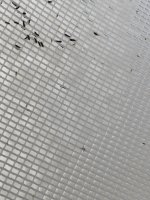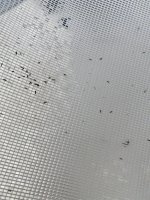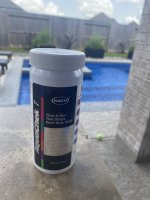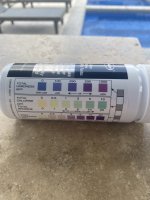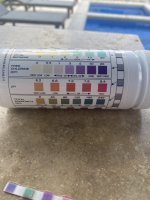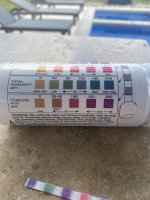Anyone have any idea what these tiny bugs are? They are very small black bugs, smaller than a gnat. I first noticed them about 2 months ago after a heavy rain and cannot get rid of them, they keep coming back. They will go completely away and then come back, but it’s not just with rain now. I can’t figure out what brings them back. They form in clusters together and float and look like they may jump around, especially if I disturb them by skimming them out. I’ve had a pool cleaning company come out and he told me they look like they could be fleas but said the pool looked fine and we don’t have any vegetation that could be causing it. We’ve only been in our house since March and our pool went in right after, we have a fiberglass pool. We have had our yard sprayed regularly by our pest control company also and I’ve done it once myself.
In addition to these bugs, we have backswimmers that I cannot get rid of! I’ve scrubbed our pools walls and I’ve even gone around the entire pool and hand cleaned every wall and step and they are still coming back. At first we had a lot I’d say 20 or so, but now everyday I pull anywhere from 5-7 out but this morning there were 13. These backswimmers and the other bugs came about the same time and I’ve been battling them since.
I’ve taken the pool water to get tested at the pool store and I bought test strips to test myself. When I test it the levels are all fine., however every time I go into the pool store to test the water there is always something it needs. I shock it once a week and use a perfect weekly as well, just as their system recommends. We have an automatic chlorinator as well that we kept maintained with tabs. Here are the reading from this morning, pH level is low and the TC and FC are high. I also included photos of the strips I use.
Total Hardness - 100
Total Chlorine - 10
Total Bromine - 20
FC - 10
pH - 6.8
Total Alkalinity - between 80-120
Cyanuric Acid - 100
In addition to these bugs, we have backswimmers that I cannot get rid of! I’ve scrubbed our pools walls and I’ve even gone around the entire pool and hand cleaned every wall and step and they are still coming back. At first we had a lot I’d say 20 or so, but now everyday I pull anywhere from 5-7 out but this morning there were 13. These backswimmers and the other bugs came about the same time and I’ve been battling them since.
I’ve taken the pool water to get tested at the pool store and I bought test strips to test myself. When I test it the levels are all fine., however every time I go into the pool store to test the water there is always something it needs. I shock it once a week and use a perfect weekly as well, just as their system recommends. We have an automatic chlorinator as well that we kept maintained with tabs. Here are the reading from this morning, pH level is low and the TC and FC are high. I also included photos of the strips I use.
Total Hardness - 100
Total Chlorine - 10
Total Bromine - 20
FC - 10
pH - 6.8
Total Alkalinity - between 80-120
Cyanuric Acid - 100


